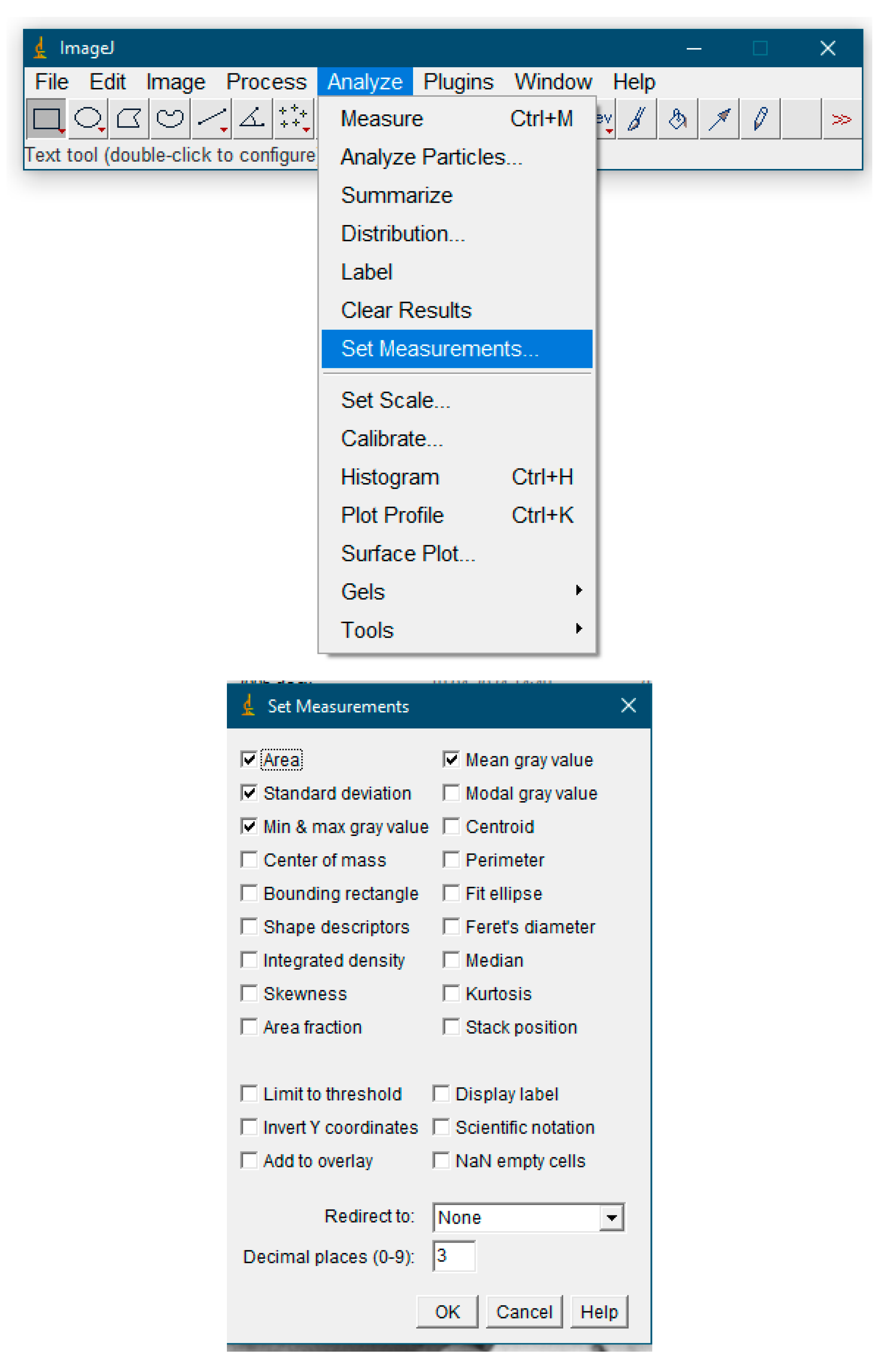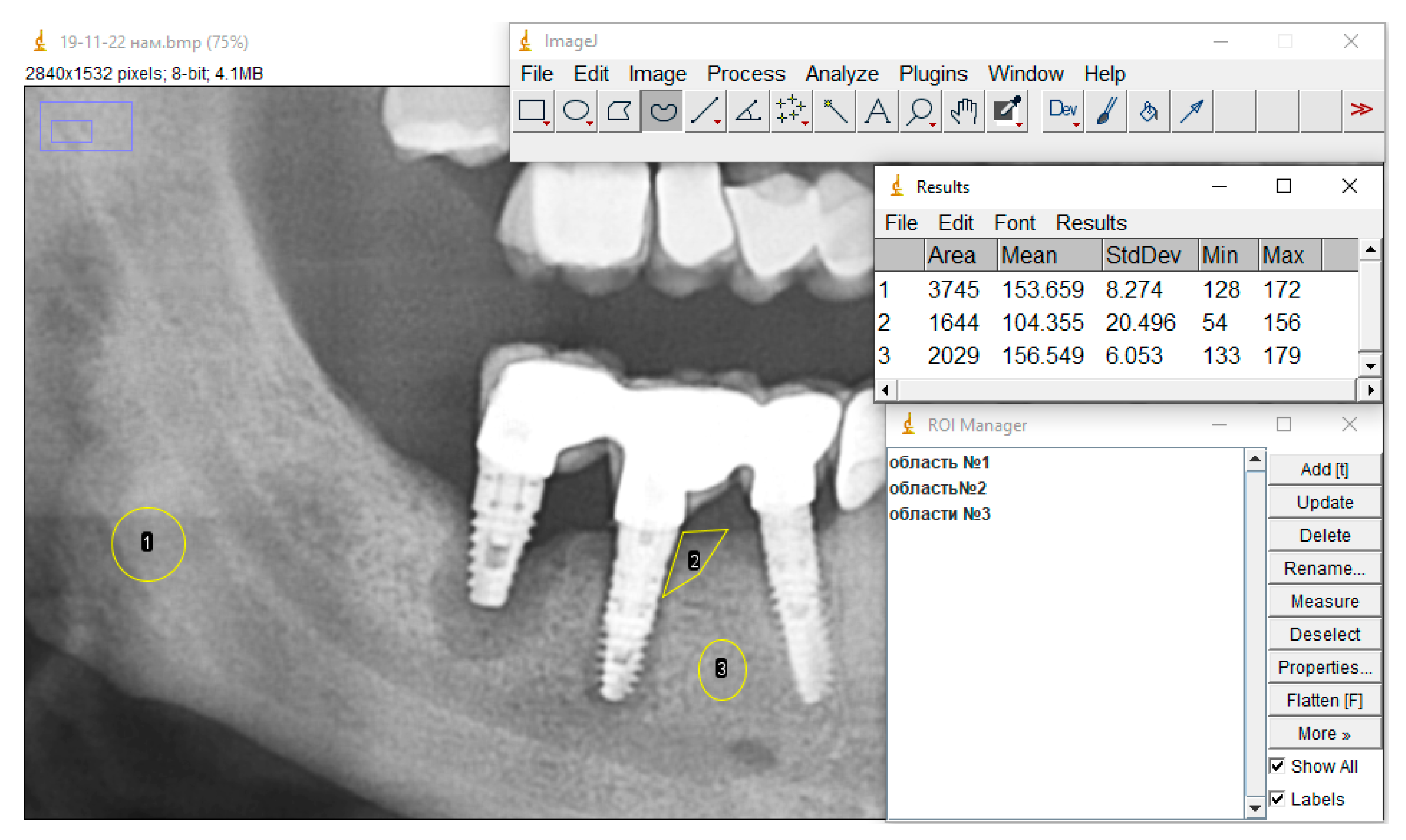A New Method for the Digital Assessment of the Relative Density of Bone Tissue in Dentistry Using the ImageJ Software Package
Abstract
1. Introduction
2. Materials and Methods
- Set the measurement function parameters. Select the Analyze > Set Measurements menu to set the parameters that will be used in the measurements: area, average gray value, standard deviation, maximum and minimum gray value in the selected area (Figure 1).
- Open the X-ray image file. To do this, select the File > Open menu and specify the path to the image or drag the image. If you need to improve image quality, you can use additional processing functions.
2.1. Image Preprocessing
- 3.
- When there was a visual artifact of uneven illumination (assessed by three researchers);
- 4.
- When SNR < 20 dB (calculated via Analyze → Tools → Noise Estimation);
- 5.
- When the variation coefficient was >15% in control measurements;
- 6.
- Selection of ROI (area of interest).
2.2. ROI Selection Standardization Protocol
2.3. Inter-Operator Variability Assessment (ICC)
- -
- Jaw angle: ICC = 0.982 (95% CI 0.971–0.991)
- -
- Alveolar ridge: ICC = 0.945 (95% CI 0.912–0.968)
- -
- Pathological areas: ICC = 0.891 (95% CI 0.832–0.931)
2.4. Blinded Repeated Measurement
- -
- 30% of images were re-processed by three independent observers
- -
- Inter-Operator Variability Coefficient
- -
- For reference area: 1.2 ± 0.4%
- -
- For defects: 4.7 ± 1.1%
2.5. Control of Operator-Dependent Variability
- 7.
- Take the necessary measurements. If there is only one selection area, then the Analyze > Measure command for the previously set Set Measurements parameters in the special “Results” window will display the measurement results. If ROI Manager was used and many ROIs were selected, then to get the result one must select the Measure item (Figure 3).
- -
- Required sample size: 17 per group (34 measurements in total).
- -
- Actual size in the study:
- ○
- Healthy areas: 55 ROI (exceeds calculation).
- ○
- Pathological areas: 18 ROI (sufficient).
3. Results
Clinical Case Study
4. Discussion
- ICC > 0.9 for key regions;
- CV < 5% for reference areas.
5. Conclusions
6. Limitations
- A Bayesian approach with informed prior distributions;
- Sensitivity analysis with effect variation.
- Dependence on the quality of the original images;
- Need for training on working with ROI (min. 10 training cases);
- Influence of shooting parameters (requires calibration of the device).
Author Contributions
Funding
Institutional Review Board Statement
Informed Consent Statement
Conflicts of Interest
Appendix A
| Number of Areas | Location of the Study Area |
|---|---|
| 9 | 3.5–3.4 |
| 10 | 3.6–3.5 |
| 10 | 3.7–3.6 |
| 8 | 4.5–4.4 |
| 9 | 4.6–4.5 |
| 9 | 4.7–4.6 |
| No. | State of the Study Area |
|---|---|
| 1 | Condition before treatment of peri-implantitis |
| 2 | Observation after treatment of peri-implantitis |
| 3 | Condition before treatment of peri-implantitis |
| 4 | Observation after treatment of peri-implantitis |
| 5 | Condition before treatment of peri-implantitis |
| 6 | Observation after treatment of peri-implantitis |
| 7 | Condition before cystectomy |
| 8 | Condition before cystectomy |
| 9 | Control radiograph 6 months after surgery |
| 10 | Control radiograph 6 months after surgery |
| 11 | Condition before tooth extraction with periapical lesion |
| 12 | Condition before tooth extraction with periapical lesion |
| 13 | Condition before tooth extraction with periapical lesion |
| 14 | Condition before tooth extraction with periapical lesion |
| 15 | Control radiograph 6 months after extraction |
| 16 | Control radiograph 6 months after extraction |
| 17 | Control radiograph 6 months after extraction |
| 18 | Control radiograph 6 months after extraction |
| Number of Areas | Location of the Study Area | Ratio of Averages Density of the Area of Interest/Density of the Jaw Angle | Standard Deviation | The Coefficient of Variation |
|---|---|---|---|---|
| 9 | 3.5–3.4 | 1.082 | 0.048 | 0.044 |
| 10 | 3.6–3.5 | 1.068 | 0.064 | 0.059 |
| 10 | 3.7–3.6 | 1.008 | 0.059 | 0.058 |
| 8 | 4.5–4.4 | 1.087 | 0.053 | 0.048 |
| 9 | 4.6–4.5 | 1.063 | 0.035 | 0.032 |
| 9 | 4.7–4.6 | 1.011 | 0.033 | 0.032 |
| Average value | 1.052 | 0.058 | 0.055 ± 0.011 |
| No. | State of the Study Area |
|---|---|
| 1 | Condition before treatment of peri-implantitis |
| 2 | Condition before treatment of peri-implantitis |
| 3 | Condition before treatment of peri-implantitis |
| 4 | Condition before cystectomy |
| 5 | Condition before cystectomy |
| 6 | Condition before tooth extraction with periapical lesion |
| 7 | Condition before tooth extraction with periapical lesion |
| 8 | Condition before tooth extraction with periapical lesion |
| 9 | Condition before tooth extraction with periapical lesion |
| No. | m2/m1 | ||||||
|---|---|---|---|---|---|---|---|
| 1 | 9928.00 | 178.00 | 8.65 | 9606.00 | 120.00 | 14.45 | 0.67 |
| 2 | 6144.00 | 194.40 | 13.86 | 5500.00 | 110.13 | 13.10 | 0.57 |
| 3 | 9155.00 | 197.00 | 11.00 | 1889.00 | 105.00 | 12.00 | 0.53 |
| 4 | 8900.00 | 142.00 | 7.90 | 2925.00 | 112.00 | 9.00 | 0.79 |
| 5 | 6564.00 | 143.70 | 8.00 | 2365.00 | 84.70 | 6.60 | 0.59 |
| 6 | 12,415.00 | 173.00 | 9.00 | 15,765.00 | 103.00 | 19.00 | 0.60 |
| 7 | 10,567.00 | 159.00 | 17.00 | 6889.00 | 115.00 | 13.00 | 0.72 |
| 8 | 3956.00 | 123.00 | 5.70 | 4013.00 | 98.00 | 8.50 | 0.80 |
| 9 | 5994.00 | 145.00 | 9.00 | 4420.00 | 68.00 | 19.00 | 0.47 |
| Average values | 8180.33 | 161.68 | 10.01 | 5930.22 | 101.76 | 12.74 | 0.64 |
| Average coefficient | 0.11 | ||||||
References
- Gupta, A.; Devi, P.; Srivastava, R.; Jyoti, B. Intra oral periapical radiography—Basics yet intrigue: A review. Bangladesh J. Dent. Res. Educ. 2014, 4, 83–87. [Google Scholar] [CrossRef]
- Yau, H.-T.; Lin, Y.; Tsou, L.; Lee, C. An Adaptive Region Growing Method to Segment Inferior Alveolar Nerve Canal from 3D Medical Images for Dental Implant Surgery. Comput.-Aided Des. Appl. 2013, 5, 743–752. [Google Scholar] [CrossRef]
- Kumar, R.; Khambete, N.; Priya, E. Extraoral periapical radiography: An alternative approach to intraoral periapical radiography. Imaging Sci. Dent. 2011, 41, 161–165. [Google Scholar] [CrossRef] [PubMed]
- Chibisova, M.A.; Batyukov, N.M. Methods of X-ray examination and modern radiation diagnostics used in dentistry. Inst. Dent. 2020, 3, 24–33. (In Russian) [Google Scholar]
- Moiseev, D.A.; Kopetsky, I.S.; Nikolskaya, I.A.; Ilyukhin, G.S.; Gazarov, S.Y.; Madatyan, G.K.; Sevastyanova, V.V.; Kurbatina, A.B. The problem of primary infection in endo-periodontal lesions: A systematic review. Endod. Today 2023, 21, 115–123. (In Russian) [Google Scholar] [CrossRef]
- Moiseev, D.A.; Heigetyan, A.V.; Karammaeva, M.R.; Zadorozhny, A.V.; Zadorozhny, M.A.; Feoktistova, D.V. A new method of intraperiopocket galvanophoresis as part of the complex therapy of fast-progressive periodontitis. Clin. Dent. 2024, 27, 118–125. [Google Scholar] [CrossRef]
- Arzhantsev, A.P. Radiological manifestations of jaw cysts. The Russian electronic. J. Radiat. Diagn. 2019, 2, 17–29. [Google Scholar] [CrossRef]
- Natto, Z.S.; Almeganni, N.; Alnakeeb, E.; Bukhari, Z.; Jan, R.; Iacono, V.J. Peri-Implantitis and Peri-Implant Mucositis Case Definitions in Dental Research: A Systematic Assessment. J. Oral Implantol. 2019, 45, 127–131. [Google Scholar] [CrossRef] [PubMed]
- Shatta, A.; Bissada, N.F.; Ricchetti, P.; Paes, A.; Demko, C. Impact of Implant and Site Characteristics on the Pattern of Bone Loss in Peri-implantitis. Int. J. Oral Maxillofac. Implant. 2019, 34, 1475–1481. [Google Scholar] [CrossRef]
- Ryumshin, R.A.; Davydova, O.B.; Savvidi, K.G.; Piekalnits, I.Y.; Kostin, I.O. Assessment of X-ray bone density in middle-aged patients with moderate chronic periodontitis. Tver Med. J. 2020, 4, 40–43. (In Russian) [Google Scholar]
- Doube, M.; Kłosowski, M.M.; Arganda-Carreras, I.; Cordelières, F.P.; Dougherty, R.P.; Jackson, J.S.; Schmid, B.; Hutchinson, J.R.; Shefelbine, S.J. BoneJ: Free and extensible bone image analysis in ImageJ. Bone 2010, 47, 1076–1079. [Google Scholar] [CrossRef]
- Khojastepour, L.; Mohammadzadeh, S.; Jazayeri, M.; Omidi, M. In vitro Evaluation of the Relationship between Gray Scales in Digital Intraoral Radiographs and Hounsfield Units in CT Scans. J. Biomed. Phys. Eng. 2017, 7 (Suppl. S1), 289–298. [Google Scholar] [PubMed]
- Lemos, A.D.; Katz, C.R.; Heimer, M.V.; Rosenblatt, A. Mandibular asymmetry: A proposal of radiographic analysis with public domain software. Dent. Press J. Orthod. 2014, 19, 52–58. [Google Scholar] [CrossRef] [PubMed]
- Preus, H.R.; Torgersen, G.R.; Koldsland, O.C.; Hansen, B.F.; Aass, A.M.; Larheim, T.A.; Sandvik, L. A new digital tool for radiographic bone level measurements in longitudinal studies. BMC Oral Health 2015, 15, 107. [Google Scholar] [CrossRef] [PubMed]
- Elsayed, M.A. Multiparameter Image Analysis to Evaluate Dentinal Tubules Patency after Using Different Irrigation Protocols. Sci. Dent. J. 2022, 6, 36–41. [Google Scholar] [CrossRef]
- NurFadhilah, A.; Masriadi; Mohammad, D.U.; Sarafin, A.; Mila, F.; Harun, A.; Sitti Fadhillah, O.M.; Amanah, P.; Karnila. Comparision Analysis between of Software Imagej and Adaptive Region Growing Approach Android-Based in Determining the Width of Periapical Abscess Lesions. Ann. Rom. Soc. Cell Biol. 2021, 25, 10698–10705. Available online: https://api.semanticscholar.org/CorpusID:238603179 (accessed on 15 August 2025).
- Hisham, S.; Abdullah, N.; Mohamad, N.; Mohamad, H.; Franklin, D. Quantification of secondary dentin formation using dental orthopantomographs in a contemporary Malaysian population. Aust. J. Forensic Sci. 2019, 51 (Suppl. S1), S180–S183. [Google Scholar] [CrossRef]
- Williams, C.; Wu, Y.; Bowers, D.F. ImageJ analysis of dentin tubule distribution in human teeth. Tissue Cell 2015, 47, 343–348. [Google Scholar] [CrossRef] [PubMed]
- Ihan, H.N.; Miljavec, M. Spontaneous bone healing of the large bone defects in the mandible. Int. J. Oral Maxillofac. Surg. 2008, 37, 1111–1116. [Google Scholar] [CrossRef] [PubMed]
- Geiger, M.; Blem, G.; Ludwig, A. Evaluation of ImageJ for Relative Bone Density Measurement and Clinical Application. J. Oral Health Craniofac Sci. 2016, 1, 012–021. [Google Scholar] [CrossRef]





Disclaimer/Publisher’s Note: The statements, opinions and data contained in all publications are solely those of the individual author(s) and contributor(s) and not of MDPI and/or the editor(s). MDPI and/or the editor(s) disclaim responsibility for any injury to people or property resulting from any ideas, methods, instructions or products referred to in the content. |
© 2025 by the authors. Licensee MDPI, Basel, Switzerland. This article is an open access article distributed under the terms and conditions of the Creative Commons Attribution (CC BY) license (https://creativecommons.org/licenses/by/4.0/).
Share and Cite
Ebrakhim, M.; Moiseev, D.; Strelnikov, V.; Salloum, A.; Faustova, E.; Ermolaev, A.; Enina, Y.; Velichko, E.; Vasil’ev, Y. A New Method for the Digital Assessment of the Relative Density of Bone Tissue in Dentistry Using the ImageJ Software Package. Dent. J. 2025, 13, 375. https://doi.org/10.3390/dj13080375
Ebrakhim M, Moiseev D, Strelnikov V, Salloum A, Faustova E, Ermolaev A, Enina Y, Velichko E, Vasil’ev Y. A New Method for the Digital Assessment of the Relative Density of Bone Tissue in Dentistry Using the ImageJ Software Package. Dentistry Journal. 2025; 13(8):375. https://doi.org/10.3390/dj13080375
Chicago/Turabian StyleEbrakhim, Mariya, Denis Moiseev, Valery Strelnikov, Alaa Salloum, Ekaterina Faustova, Aleksandr Ermolaev, Yulianna Enina, Ellina Velichko, and Yuriy Vasil’ev. 2025. "A New Method for the Digital Assessment of the Relative Density of Bone Tissue in Dentistry Using the ImageJ Software Package" Dentistry Journal 13, no. 8: 375. https://doi.org/10.3390/dj13080375
APA StyleEbrakhim, M., Moiseev, D., Strelnikov, V., Salloum, A., Faustova, E., Ermolaev, A., Enina, Y., Velichko, E., & Vasil’ev, Y. (2025). A New Method for the Digital Assessment of the Relative Density of Bone Tissue in Dentistry Using the ImageJ Software Package. Dentistry Journal, 13(8), 375. https://doi.org/10.3390/dj13080375






